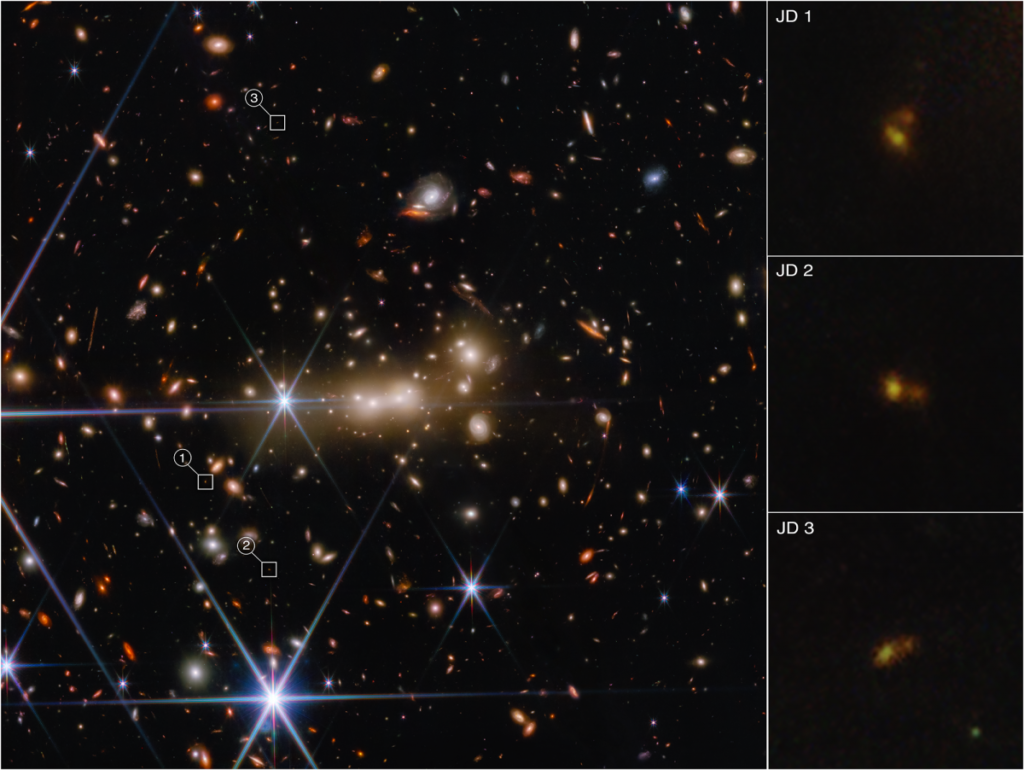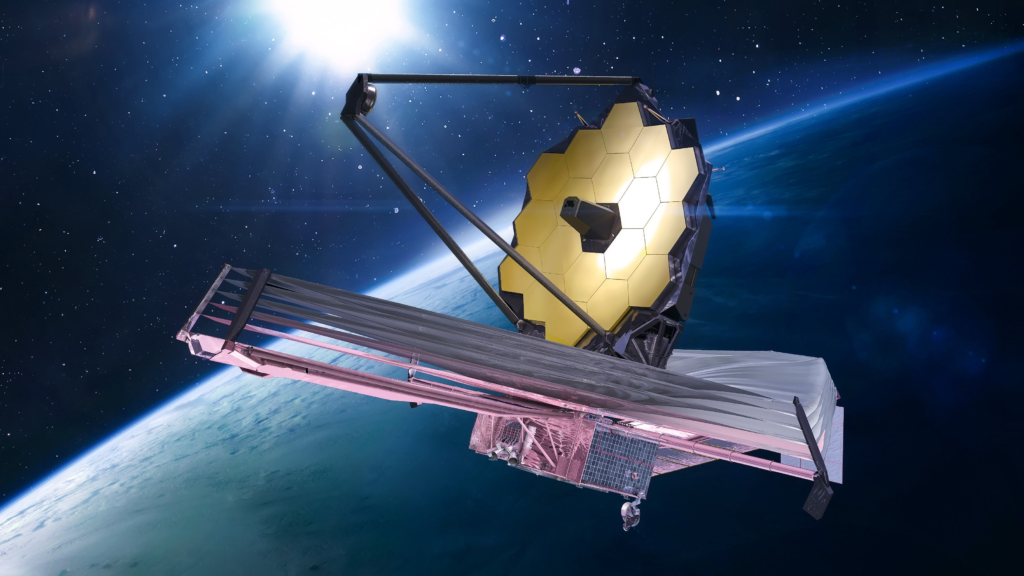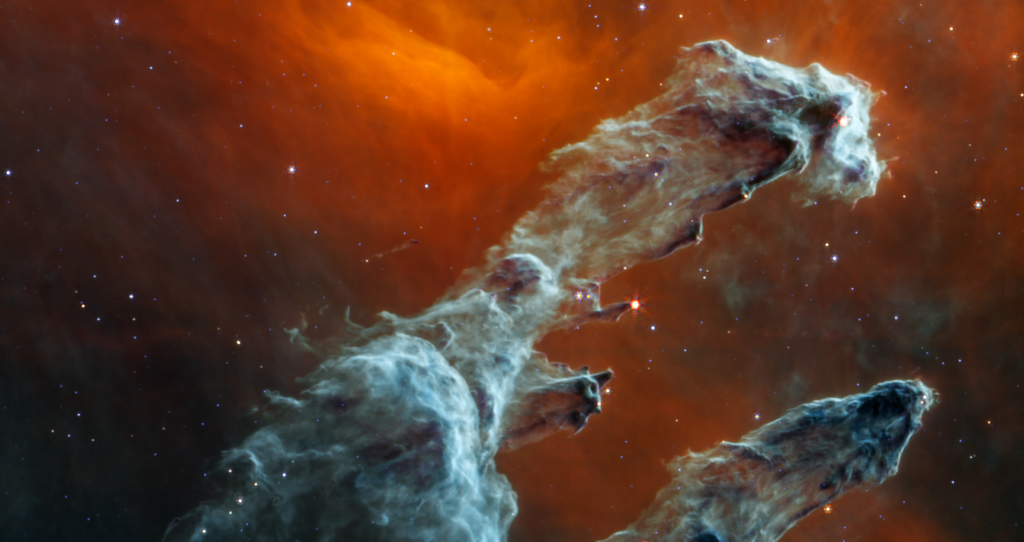
New Webb Images Show Never Before Seen Detail of Early Universe
The James Webb Space Telescope has been staying very busy since its launch almost one year ago. After completing all of its necessary deployments and general tasks, the telescope began capturing fascinating images of the universe and its past. In the last couple of days, the agency revealed a few brand new images that help put in perspective how special this telescope is.
NASA points out that in this image, they are able to see more detail than ever before of the early universe. This unique opportunity is clear when compared to an image taken of the same galaxy by Hubble. Specifically, the massive gravity of galaxy cluster MACS0647 acts as a cosmic lens to bend and magnify light from the more distant system.
All of which comes in addition to a few other images taken by Webb recently released by the agency that shows the Pillars of Creation like never before. Not to mention the James Webb Space Telescope’s full schedule with even more ambitious images planned in the near future. Here I will go more in-depth into Webb’s most recent images, why they are so important, what to expect in the future, and more.
New Galaxy Detail

Just two days ago on October 26th NASA released some brand new images from the James Webb Space Telescope. The agency tweeted saying, “The combination of Webb’s super powerful vision and a magnifying trick of gravity is allowing astronomers to resolve things never before seen in the early universe. Let’s dive into the mysteries of distant galaxy MACS0647-JD.” Webb was specially designed to detect the faint infrared light from very distant galaxies and give astronomers a glimpse at the early universe. The nature of galaxies during this early period of our universe is not well known nor understood. But with the help of gravitational lensing by a cluster of galaxies in the foreground, faint background galaxies can be magnified and also appear multiple times in different parts of the image.
Specifically, when looking at the image, the massive gravity of galaxy cluster MACS0647 acts as a cosmic lens to bend and magnify light from the more distant system. It also triply lensed the JD system, causing its image to appear in three separate locations. These images, which are highlighted with white boxes, are marked JD1, JD2, and JD3; zoomed-in views are shown in the panels on the right. While this brand new image has not yet gone through the peer review process, scientists highlighted some of the context and importance of what exactly was captured. For example, one team member from John Hopkins University commented, “You can also see that the colors between the two objects are so different. One’s bluer; the other one is redder. The blue gas and the red gas have different characteristics. The blue one actually has a very young star formation and almost no dust, but the small, red object has more dust inside, and is older. And their stellar masses are also probably different. It’s really interesting that we see two structures in such a small system. We might be witnessing a galaxy merger in the very early universe. If this is the most distant merger, I will be really ecstatic!”
In addition to the image itself, NASA posted a comparison between Webb’s recent image and one taken from Hubble back in 2012. This comparison really highlighters the power of Webb with a much brother image and clearer objects throughout the image. The panels on the right of the image are especially clear when side by side with Hubble’s original image. Dan Coe who discovered the galaxy a decade ago with Hubble commented, “With Hubble, it was just this pale, red dot. We could tell it was really small, just a tiny galaxy in the first 400 million years of the universe. Now we look with Webb, and we’re able to resolve TWO objects! We’re actively discussing whether these are two galaxies or two clumps of stars within a galaxy.
Not to mention, Rebecca Larson of the University of Texas at Austin highlighted, “Up to this point, we haven’t really been able to study galaxies in the early universe in great detail. We had only tens of them prior to Webb. Studying them can help us understand how they evolved into the ones like the galaxy we live in today. And also, how the universe evolved throughout time. I think my favorite part is, for so many new Webb images we get, if you look in the background, there are all these little dots—and those are all galaxies! Every single one of them. It’s amazing the amount of information that we’re getting that we just weren’t able to see before. And this is not a deep field. This is not a long exposure. We haven’t even really tried to use this telescope to look at one spot for a long time. This is just the beginning!
MIRI Pillars of Creation

While the recent image showing new detail of the early universe is fascinating, just earlier today NASA released another incredible image this time taken using the MIRI instrument. Specifically, this morning NASA tweeted saying, “You can’t escape its clutches. Just in time for #Halloween, the Pillars of Creation reach back out like a ghostly hand. The eerie landscape, captured this time by Webb’s mid-infrared instrument (MIRI), spotlights ancient curtains of dust in new detail.”
NASA’s James Webb Space Telescope’s mid-infrared view of the Pillars of Creation strikes a chilling tone. Thousands of stars that exist in this region seem to disappear, since stars typically do not emit much mid-infrared light, and seemingly endless layers of gas and dust become the centerpiece. The detection of dust by Webb’s Mid-Infrared Instrument (MIRI) is extremely important – dust is a major ingredient for star formation. Thousands and thousands of stars have formed in this region. This is made plain when examining Webb’s recent Near-Infrared Camera (NIRCam) image. In MIRI’s view, the majority of the stars appear missing. This is because many newly formed stars are no longer surrounded by enough dust to be detected in mid-infrared light. Instead, MIRI observes young stars that have not yet cast off their dusty “cloaks.” These are the crimson orbs toward the fringes of the pillars. In contrast, the blue stars that dot the scene are aging, which means they have shed most of their layers of gas and dust.
Mid-infrared light excels at observing gas and dust in extreme detail. This is also unmistakable throughout the background. The densest areas of dust are the darkest shades of gray. The red region toward the top, which forms an uncanny V, like an owl with outstretched wings, is where the dust is diffuse and cooler. Notice that no background galaxies make an appearance – the interstellar medium in the densest part of the Milky Way’s disk is too swollen with gas and dust to allow their distant light to penetrate. This scene was first captured by NASA’s Hubble Space Telescope in 1995 and revisited in 2014, but many other observatories, like NASA’s Spitzer Space Telescope, have also gazed deeply at the Pillars of Creation. With every observation, astronomers gain new information, and through their ongoing research build a deeper understanding of this star-forming region. Each wavelength of light and advanced instrument delivers far more precise counts of the gas, dust, and stars, which inform researchers’ models of how stars form. As a result of the new MIRI image, astronomers now have higher resolution data in mid-infrared light than ever before, and will analyze its far more precise dust measurements to create a more complete three-dimensional landscape of this distant region. The Pillars of Creation is set within the vast Eagle Nebula, which lies 6,500 light-years away.
In comparison, just earlier this month NASA released more images of the Pillars of Creation using the Near Infrared Camera. In this case, newly formed stars are the scene-stealers in this image. These are the bright red orbs that typically have diffraction spikes and lie outside one of the dusty pillars. When knots with sufficient mass form within the pillars of gas and dust, they begin to collapse under their own gravity, slowly heat up, and eventually form new stars. Here you can even see wavy lines that look like lava at the edges of some pillars. These are ejections from stars that are still forming within the gas and dust. Young stars periodically shoot out supersonic jets that collide with clouds of material, like these thick pillars. This sometimes also results in bow shocks, which can form wavy patterns like a boat does as it moves through water. The crimson glow comes from the energetic hydrogen molecules that result from jets and shocks. This is evident in the second and third pillars from the top – the NIRCam image is practically pulsing with their activity. These young stars are estimated to be only a few hundred thousand years old. All of which help cement what Webb is truly capable of.
Conclusion
The James Webb Space Telescope has been busy since its launch almost one year ago in December 2021. Since then it has managed to capture some of the most incredible images ever taken of the Universe. As time goes on we can expect to see much more as Webb’s schedule is filled to the brim with observations. We will have to wait and see how it progresses and the impact it has on the space industry.
